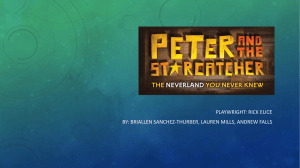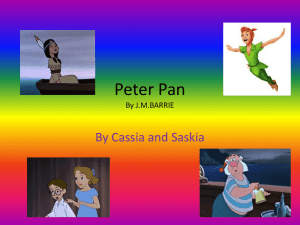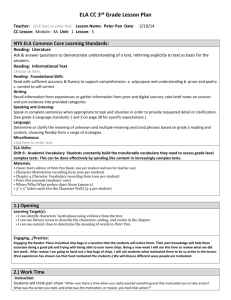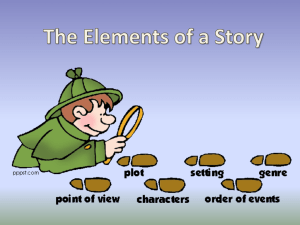Study Guide Peter Pan Presented by Theatreworks USA
advertisement
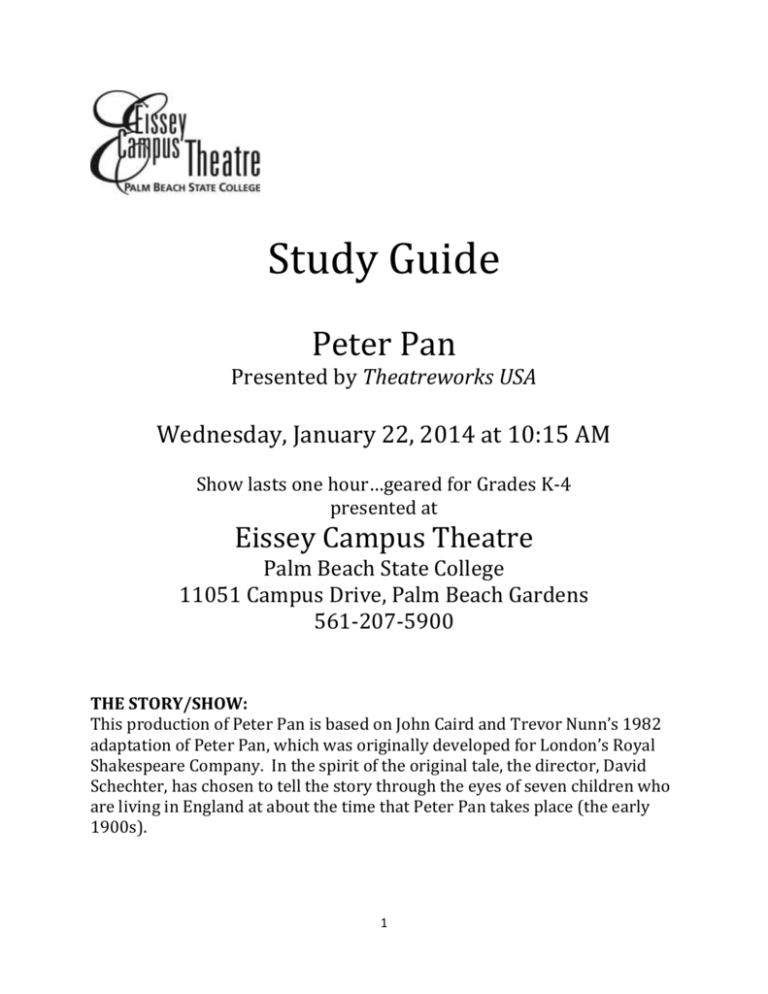
Study Guide Peter Pan Presented by Theatreworks USA Wednesday, January 22, 2014 at 10:15 AM Show lasts one hour…geared for Grades K-4 presented at Eissey Campus Theatre Palm Beach State College 11051 Campus Drive, Palm Beach Gardens 561-207-5900 THE STORY/SHOW: This production of Peter Pan is based on John Caird and Trevor Nunn’s 1982 adaptation of Peter Pan, which was originally developed for London’s Royal Shakespeare Company. In the spirit of the original tale, the director, David Schechter, has chosen to tell the story through the eyes of seven children who are living in England at about the time that Peter Pan takes place (the early 1900s). 1 The play opens as they appear in their playroom just as Big Ben (the large clock in London) strikes 11:00. After going through a few book titles, the story of Peter Pan is decided upon for that evening’s play-acting, and the adventure begins as the storyteller starts reading. As the story unfolds, each of the children takes a part, beginning with the sweet Mrs. Darling, the officious Mr. Darling, and their three children, Wendy, John, and Michael. The family is quite typical for Edwardian England except for the fact that they have a large dog, Nana, acting as the children’s nurse. As the Darlings are about to go out for a fancy dinner, Mrs. Darling expresses her worries about leaving the children alone, since lately she’s noticed a young boy at the window and even has the shadow he left behind as proof. When Nana is unable to watch over the children (having been put outside by Mr. Darling), sure enough, Peter Pan returns to retrieve his shadow, which is sewn back on by the maternal Wendy. Peter admits that he was drawn to the Darling household by the stories told by their mother, and makes Wendy the tempting offer of becoming a mother herself to the Lost Boys back in Never Land, as well as hobnobbing with fairies (among them, Peter’s companion, Tinkerbell) and mermaids. John and Michael, excited by the prospect of pirates, are also lured into the adventure. Their minds are made up when Peter teaches them how to fly (which the children act out by making their dolls fly), and they go off to Never Land by following Peter’s directions, A second star on the right, and straight on till morning. Never Land proves to be both magical and dangerous. Wendy is happy to meet the Lost Boys, Tootles and Slightly (even though the jealous Tinkerbell tricks them into shooting her with an arrow!), and even convinces Peter to play the father in their family (although he would rather be a little boy, being averse to even pretending to be a grownup). No one is safe, however, with the pirate Captain Hook seeking to avenge his lost arm (taken from him by the Lost Boys’ own captain, Peter Pan, who flung it to a crocodile). Hook and his cohort, Smee, attempt to take Wendy away from the Lost Boys, and make them their own mother. Hook devises a series of dastardly plans, including a cake made from a deathly green sugar, and adding poison to Peter’s medicine. Peter is saved time and time again, by luck (the fortuitous appearance of the crocodile, who can be heard approaching by the ticking of the clock he swallowed), by friendship (Tinkerbell taking the poison meant for him; luckily the dying fairy is saved by the applause of children who believe in fairies), and by his own cleverness and sword-fighting skills. Wendy, John, and Michael, 2 after their release from the pirates’ capture, have had enough of adventure and decide to go home. Their consciences also remind them that their own mother must be worried, and so Peter and the Lost Boys escort them back into Mrs. Darling’s loving arms. Although they convince Tootles and Slightly to join their family, Peter refuses the offer if it comes with the necessity to learn solemn things. Reluctantly leaving Wendy, he nonetheless flies back to Never Land, where he can pursue his heart’s desire to always to be a boy and to have fun. THE ARTISTS: Theatreworks USA is a New York based production company that provides programming for school shows throughout the United States. CAST (alphabetical by role) Hook/Father.............................................................................................................................Christian Castro John .............................................................................................................................................Ryan Frostig Michael.... ...............................................................................................................................Madeline Kolker Mrs. Darling/Smee............................................................................................................................Jojo Karlin Peter ................ ....................................................................................................................Hannah Timmons Wendy.... .......................................................................................................................Sara Glancy PRE-PERFORMANCE DISCUSSIONS: 1. Discuss how students should behave at the theatre. a. No food or drinks inside the theatre b. No gum chewing c. No cell phones d. Respect for the performers on stage e. Clapping where appropriate 3 2. Have a class discussion about fairy tales and other stories that have makebelieve elements. What kinds of things can happen in a story that would not be possible in the real world? Introduce the story of Peter Pan in light of this discussion, talking about the fantastic elements of the story, i.e. mermaids, fairies, and the fact that people can learn how to fly! (Note: this production is relatively faithful to the original, except that the Indian tribe is omitted.) Follow up with a post-performance discussion. 3. This production of Peter Pan is set in a children’s playroom in England in the early 1900s (before television and video games), and the story is “acted out” by the children who come to play there. Introduce students to this concept by reading a book aloud (preferably one with “magical” events) and having them “act out” the story. Follow up with a discussion of the way that the “children” in the play acted out the tale of Peter Pan. 4. One of the themes of the story of Peter Pan is “growing up” -- Peter doesn’t want to grow up, while Wendy can’t wait to grow up and take care of the other children. How do your students feel about growing up -- what are the advantages of being an adult? What are the disadvantages? Compare these to the “pros” and “cons” of being a child. (Do they think that grownups ever wish that they were still children?) Follow up after the performance. 5. For younger children especially, you may want to go over some basic vocabulary words that they will hear in the play. (See below). Review after seeing the play. nurse (as in child’s nurse, like a nanny) clever fairy (and fairy dust) spool (as in “spool of thread”) lagoon pirates mermaid 4 CLASSROOM ACTIVITIES: 1. ACT OUT A STORY - Read a book aloud that has fantasy elements, and have the class take parts and act the story out the way the children in the play did. Be creative! 2. YOUR OWN NEVER LAND - In one version of the story, J.M. Barrie described Never Land as a place that children go to in their sleep, which would look different for each child. What do you think your Never Land would look like? Would there be mermaids and pirates? Would you live under the ground, like Peter and the Lost Boys? Write an essay describing your own private Never Land, or draw a picture of it. (Variation: As a class, design a mural depicting the Never Land in Peter Pan or your own version.) 3. PIRATES! - Captain Hook is one of the most famous pirates in fiction. Can you think of other pirates that you’ve read about or seen in plays, on television, or in movies? (One example is Long John Silver from Robert Louis Stevenson’s Treasure Island.) Research fictional and/or real life pirates and write an essay about them. 4. A DEAR MOTHER - As one of the Darling children, write a letter home to your mother (or your father), letting them know that you’re safe in Never Land (and that you miss them?). Describe some of the amazing things that you’ve seen and done since your arrival! 5. PERSONAL FAIRIES - Imagine that you have your own personal fairy. What kinds of everyday things could your fairy help you out with? (Cleaning your room, perhaps?) Would your fairy play games or sing songs? What would your fairy look like? Describe your personal fairy (with words and/or pictures) and give him or her a name. 6. A SECOND STAR TO THE RIGHT - Create a map to Never Land (this would also be a good class project, in a large format). What do you see as you fly over London on your way to the second star to the right and straight on..., and how long does it take until morning? Be sure to include sites to see, such as the Mermaid’s Lagoon, Marooner’s Rock, etc. (Variation: Do the same thing in the form of a board game, using dice or question cards in order to advance along your map on your way to Never Land..) 5 POST PERFORMANCE DISCUSSIONS: 1. In reference to the discussion that you had before seeing the play (if applicable), talk about the make-believe elements of the performance. How did the actors show that they were “flying”? What other things happened in the play that were not realistic? What was their favorite “make-believe” part of the story? 2. In the play, Captain Hook is the villain. What kinds of things did Captain Hook do that illustrated that he was the “bad guy”? (For instance, he usually resorts to tricks and never fights fair.) What kinds of things did Peter do to outsmart Captain Hook? Did Peter always fight fair? 3. Peter lures Wendy to Never Land by telling her that the Lost Boys need a mother. (Even the pirates conspire to steal Wendy to be their mother!) What did her presence in Never Land mean to the Lost Boys? Is this an oldfashioned idea, or do boys have to have a girl around to take care of them? Is there a difference between what a mother does and what a father does, or can either have “nurturing” qualities? 4. Peter’s fairy, Tinkerbell, is often portrayed on the stage as just a flash of light, or the tinkle of a bell, but she is never seen. How was she portrayed in the performance that you just saw? What do you think that Tinkerbell really looks like? (Avoid copying the Disney cartoon version.) How does Tinkerbell’s character compare to other “Fairy tale fairies”? (Perhaps she’s a little more mischievous than Cinderella’s Fairy Godmother, for example.) 5. If applicable, recall the discussion about growing up that you had before the performance (or bring up the topic after seeing the show). Using examples from the play, talk about what is difficult about being a grownup (for example, Mrs. Darling worries about her children, Peter fears that when he grows up he won’t be able to have fun anymore). How do you think Wendy feels about growing up? (Compare the way she feels about Peter to the way that he sees her, as a mother.) Is it still possible to have fun when you’re an adult (is Peter wrong?)? 6 6. Have a discussion about what happened at the end of the story. How would the story be different if Peter had decided to stay with the Darlings? What if Wendy had decided to return to Never Land? What do you think happens next, after Peter leaves the Darling house? Older Students: J.M. Barrie wrote an epilogue to the Peter Pan story in which Peter visits the Darling house after Wendy has become a grownup. Do you think that Wendy could return to Never Land when she is no longer a child? Why or why not? CORE CURRICULUM: NGSSS.TH.K.C.1.1, 1.2, 2.1, 2.2, 3.1 NGSSS.TH.1.C.1.1, 1.2, 2.1, 2.2, 3.1 NGSSS.TH.2.C.1.1, 1.2, 2.1, 2.2, 3.1 NGSSS.TH.3.C.1.1, 1.2, 2.1, 2.2, 3.1 NGSSS TH.4.C.1.1, 1.2, 2.1, 2.2, 3.1 FOR FURTHER INFORMATION: VIDEO Peter Pan - Among the many versions available on video are the animated feature by Walt Disney (1953) and the television broadcast of the musical play which starred Mary Martin (which first aired live on NBC in 1954). Hook - Although this 1991 version by Steven Spielberg is a twist on the original story (with Robin Williams as a grown- up@ Peter Pan), many of Barrie’s original story elements are explored, including a version of his epilogue in which Peter meets with the adult Wendy. INTERACTIVE LINKS WIKIPEDIA.ORG, a good starting place to start to learn about Peter Pan author J.M. Barrie. The site has a biography of J.M. Barrie and includes a photo of the statue of Peter Pan which stands there as a tribute to Barrie in London and links to learn about Barrie’s other works. www.en.wikipedia.org/wiki/JM_Barrie 7 FUNSCHOOL.KABOOSE.COM This website has some great activities featuring Peter Pan for younger grades, including coloring pages, on-line puzzle game, and printable activity sheets. www.disney.go.com/DisneyVideos/masterpiece/shelves/peterpan/panvs/pa nvs.htm PIRATES! This website is part of the National Geographic Kids’ pages, and explores the facts behind the legends of famous pirates. www.nationalgeographic.com/pirates/maina.html 8
